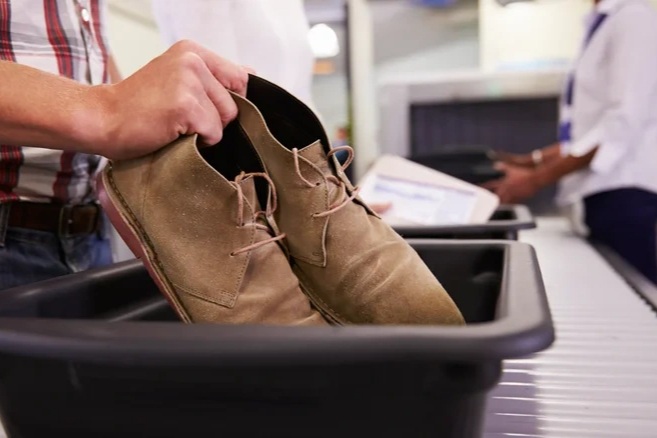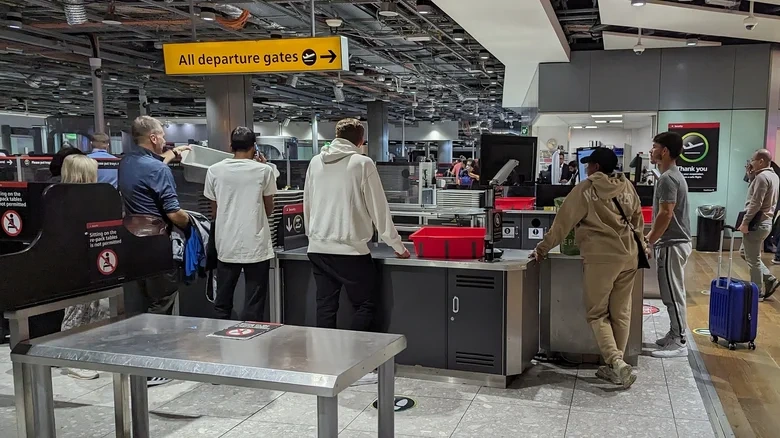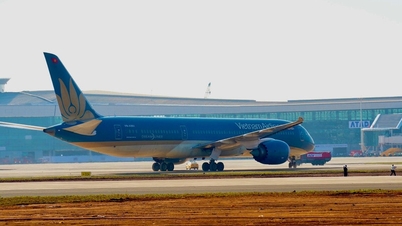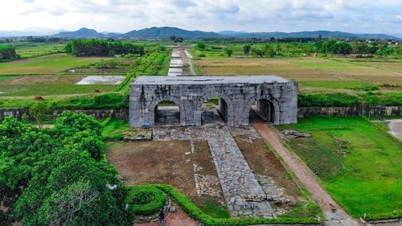In a recent noteworthy statement, Mr. Dang Hong Anh, Chairman of the Vietnam Young Entrepreneurs Association, estimated that each passenger spends 3 to 4 minutes on tasks such as removing shoes, belts, watches, or jackets, potentially wasting over 7 million hours of labor per year. If converted to the current minimum hourly wage, the economy could lose nearly 150 billion VND annually due to these inefficient procedures.
Meanwhile, he said many airports around the world have eliminated manual screening procedures thanks to investments in modern screening technologies.
So what are the security procedures like in different countries, and what are the regulations regarding removing shoes and belts when boarding an airplane?
The US has officially lifted the shoe-removal requirement at airport security.
After nearly 20 years of implementation, the U.S. Transportation Security Administration (TSA) has officially abolished the requirement for passengers to remove their shoes at airport security checkpoints.
Specifically, starting July 9th, passengers will no longer be required to remove their shoes at airport security checkpoints in the US. This change aims to improve the travel experience while ensuring safety, thanks to advanced security technology .
U.S. Transportation Security Secretary Kristi Noem said that while this regulation will become the new standard procedure for most passengers in the future.
“The U.S. Transportation Security Administration will no longer require passengers to remove their shoes when going through security checkpoints. We are ensuring both security and comfort for passengers. With this new policy, we believe that citizens, tourists, and anyone entering the United States will be pleased to no longer have to take off their shoes at the airport,” she shared with the press.
Ms. Noem stated that this change is the result of a review of the Transportation Security Administration's security and screening procedures to determine what measures are truly effective. Passengers will still have to undergo multi-layered checks and identity verification before being allowed to board the aircraft.
Speaking at Ronald Reagan Washington Airport, Ms. Noem emphasized that security technology has advanced significantly over the past 20 years. The TSA now operates a comprehensive security system, with close coordination among agencies to ensure passenger safety and national security.
However, she stated that in some cases, security personnel may still ask passengers to remove their shoes for additional checks. The TSA also affirmed that other security measures will remain in place, including identity verification, checks of flight security data, and standard procedures.

A passenger takes off their shoes before going through security at an airport in New York (Photo: Reuters).
Nicholas Calio, CEO of Airlines for America, the association representing airlines, welcomed the decision, calling it a major step forward in making air travel smoother, more seamless, and safer for passengers.
According to Nicholas Calio, making security decisions based on risk assessment and leveraging advanced technology is a very sensible policy approach.
“Sometimes taking off and putting back on shoes for young children can be quite time-consuming. My daughter doesn’t always take her shoes off or put them back on. So this really saves us time and helps us get to the right gate to board the plane quickly,” a US passenger shared after the policy was implemented. Previously, all passengers aged 12 to 75 were required to remove their shoes to be scanned along with their carry-on luggage and personal belongings.
The U.S. Transportation Security Administration is also reviewing additional regulations and procedures to simplify and expedite airport screening. Ms. Noem stated that the agency is testing dedicated lanes for military personnel and their families with young children, and expects to implement further changes within the next six to eight months.
Europe invests in CT scanning systems.
In Europe, many major airports have also invested in CT (computed tomography) scanning systems for carry-on baggage. This technology creates detailed 3D images of the objects inside, allowing security personnel to analyze them without requiring passengers to disassemble their luggage or dispose of any liquids they are carrying.
The European Commission stated that airports within the bloc are gradually installing new scanning equipment, but there will not be a simultaneous upgrade at all locations due to the high investment costs and stringent technical certification requirements. The upgrade will be implemented in stages, depending on the financial resources and technical capabilities of each EU member state.
Experts believe that the adoption of new security scanning technology is a significant step forward in increasing the efficiency of passenger screening without causing inconvenience.

Passengers remove their shoes during security checks (Photo: Shutterstock).
Several major airports in Europe, such as Heathrow (UK), Schiphol (Netherlands), and Fiumicino (Italy), began testing and deploying the new technology system in 2023 and have shown positive results in terms of both safety and speed of security screening.
This move not only makes travel more convenient for passengers but also demonstrates the EU's efforts to modernize its aviation security system, aiming to balance safety with an enhanced travel experience.
However, EU officials stressed that security remains the top priority. The implementation of new systems will always be accompanied by thorough risk assessments, and any changes to regulations will be widely communicated to the public and airlines within the bloc.
Singapore uses a security control system that incorporates AI.
Meanwhile, at Changi Airport in Singapore, they have invested in a Next-Gen Checkpoint system, using artificial intelligence (AI) and next-generation sensors to replace the entire process of removing personal accessories, enabling faster processing while ensuring absolute safety.
Specifically, the airport has applied AI to its "Automated Prohibited Items Detection System" (APIDS) project to automatically inspect carry-on baggage at Terminal 3.
The project aims to conduct a preliminary scan of all carry-on baggage. Security personnel will only need to re-examine the bags that trigger warnings from the system. This will significantly shorten security screening time, while also helping the airport reduce costs and use manpower more efficiently.
Representatives from Changi Airport stated that the testing and development process for this project is still in its early stages. In the future, the project development team will continue to add input data, improve the system's efficiency, and gradually expand the testing.
Simultaneously, Changi Airport will also work with relevant government agencies and international organizations to standardize policies and regulations for the official implementation of this technology.

Passengers line up to have their luggage checked at the airport (Photo: Shutterstock).
Previously, Changi Airport security personnel had to manually inspect approximately 10,000 pieces of carry-on luggage daily using only visual inspection and analysis of images from X-ray scanners. Experts believe this is a highly skilled and demanding job requiring a large workforce and is also very stressful and demanding.
According to information on the Singapore Immigration and Checkpoints Authority (ICA) website, since October 2024, the average time for a passenger to pass through border crossings has decreased by 60%, from 25 seconds to 10 seconds. Initial results have demonstrated high efficiency and feasibility, with processing speeds increasing by up to 50% and significantly reducing common errors during visual inspections.
Changi is considered one of the most modern airports in the world. It continuously invests in technology, helping to reduce processing times. Despite privacy concerns, Singapore believes that biometrics will shorten immigration waiting times by 40%, as well as enhance border security and improve the traveler experience.
Entry without a passport is part of a "new immigration procedure" that Singapore has long aimed to implement. According to the ICA, by early 2026, 95% of visitors are expected to use automated lanes for processing. The remaining ineligible individuals are typically young children, the elderly, or those requiring assistance.
Sumesh Patel, President of SITA, a telecommunications and aviation technology company, for the Asia-Pacific region, predicts that 85% of airports worldwide will use some form of biometric processing within the next 3-5 years.
Along with Singapore, similar systems are also being tested in China, the Netherlands, and the United States. Initial results show high feasibility and effectiveness. One study showed that processing speeds can be up to five times faster than conventional procedures and significantly reduce false alarms.
Experts also suggest that whether passengers need to remove their shoes when going through airport security depends on the regulations and risk assessment of each country. Specifically, passengers in Canada generally do not need to remove their shoes, unless flying to the US or wearing shoes with metal parts.
In South America, passengers in Argentina and Brazil are mostly allowed to keep their shoes on if the metal detectors don't sound an alarm. In Australia and New Zealand, shoe removal depends primarily on the shoe's construction. Airports like Sydney, Melbourne, and Auckland generally don't require shoes to be removed unless they contain metal or are ankle-covering and require thorough inspection.
In Japan and South Korea, this rule is also not mandatory, except in cases of oversized shoes or shoes containing metal. Airports such as Dubai (UAE), Hamad (Qatar), or Abu Dhabi usually do not require shoe removal unless there is a specific reason such as metal shoes or high heels. Here, the screening process prioritizes modern technology and randomly selects passengers for additional checks.
Source: https://dantri.com.vn/kinh-doanh/coi-giay-that-lung-kiem-tra-an-ninh-san-bay-cac-nuoc-lieu-con-ap-dung-20250802012258581.htm







![[Photo] Prime Minister Pham Minh Chinh presides over a meeting on private sector economic development.](/_next/image?url=https%3A%2F%2Fvphoto.vietnam.vn%2Fthumb%2F1200x675%2Fvietnam%2Fresource%2FIMAGE%2F2025%2F12%2F20%2F1766237501876_thiet-ke-chua-co-ten-40-png.webp&w=3840&q=75)

































































































Comment (0)